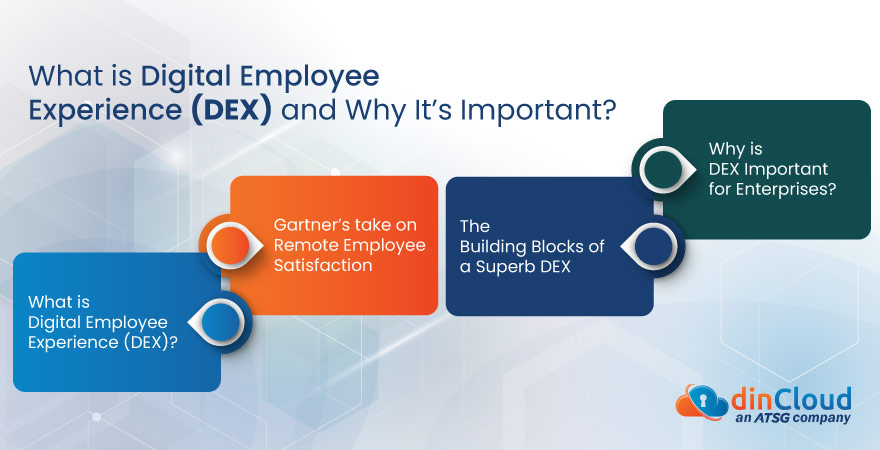The workplace has undergone massive evolution over the past months. Remote work, which used to be the exception, has now become the new normal. After the subsiding of the pandemic, the workplace has seen little to no change in remote work trends.
Enterprises are rapidly migrating towards mid to long term remote as well as hybrid work policies. However, the IT infrastructures of most organizations are not up to speed with the requirements of the modern, flexible workplace.
Companies always strive to meet and exceed customer expectations. To achieve this goal however, there is a very important piece of the puzzle, the employees. Without equipping employees with the right set of remote and hybrid work tools, this is just not possible.
Related: How Desktop as a Service (DaaS) Streamlines Hybrid Work?

What is Digital Employee Experience (DEX)?
Present day remote employees are heavily reliant on digital technologies and applications that are capable enough to get things done. The legacy IT infrastructures and tools of most organizations were never designed for working in such remote work environments.
As a result, most organizations ended up using, or retro-fitting legacy IT and collaboration tools just to get things done. However, this approach is counter productive in most cases, as it fails to deliver the flexibility and agility that present day employees expect, and want.
Gartner’s take on Remote Employee Satisfaction
Let us glance at a recent remote employee satisfaction survey that was conducted by Gartner. The findings of this study are a stark reminder for organizations that they need to up their game really quickly, when it comes to a good Digital Employee Experience (DEX).
- A mere 13% of remote employees said their company’s remote work tools were fully meeting their expectations.
- Only 21% of the surveyed employees opined that their organization’s remote work tools were just meeting their expectations, nothing special though.
- 20% of the respondent employees said their organization’s tools were partially meeting their expectations when it comes to the remote employee experience.
- An alarmingly high 46% of remote employees said their organization’s tools were NOT meeting their remote work needs and expectations.
Related: How Are Cloud Technologies Enabling Hybrid Work and Remote Collaboration?
From the above Gartner survey, it is quite evident that a lot needs to be done to elevate the Digital Employee Experience (DEX). Without proper planning, investing in resources and un-wavering commitment towards DEX initiatives, companies may not be able to meet customer’s expectations, sooner than later.
The Building Blocks of a Superb DEX
Now that we have underscored how important it is for enterprises to deliver exceptional Digital Experiences to their employees, let us highlight the major building blocks that combine to deliver a superior DEX.
Streamlining of Workflows
In a conventional, pre-pandemic workplace setting, workflow streamlining used to be a casual activity. One employee could simply slide his chair a few feet, or walk down to the neighboring workstation, and sort out any impending issues with colleagues.
In the present day hybrid and remote work setting, this is just not possible. So, remote employees need digital tools that can map the different enterprise workloads, so every employee knows what contribution or input is expected for a specific task.
Related: dinCloud Solutions – A Perfect Fit for Your Remote Work Needs
Task and Project Management Tools
In remote work settings, the relatively simpler tasks can get complicated, especially when stringent timelines or deadlines are attached to such tasks. So, it is important for enterprises to provide remote employees with task and project management tools.
By incorporating such tools, every remote employee that is part of a team or project will know exactly how much progress has been made on a certain open item, and what else needs to be done by which employee, in order to achieve the desired end result.
Unified Communications and Remote Collaboration
This is perhaps the most critical piece of the puzzle, as communication is equally important for remote employees. However, the use of different tools for emails, calling, messaging and video conferencing can become a real headache for remote employees.
Too many of such tools can otherwise frustrate employees, and waste a lot of their productive time; just switching over here and there. Instead, there should be unified communication and remote collaboration tools for a superior and smooth DEX.
By doing so, calls, meetings, messages and document sharing etc. can be done over a single platform / tool. This will not only reduce employee stress, but also streamline workflows, as employees will be able to track and trace everything within a single “repository”.
Related: The Top Digitalization Trends for the Year 2022
Why is DEX Important for Enterprises?
Traditionally, it has only been the Customer Experience (CX) that has been grabbing all the limelight. For this very reason, most of the focus and resources were diverted towards improving the overall customer experience.
While there is nothing wrong with this approach, pursuing and investing just in the CX will not deliver positive outcomes over the mid to long term. Now, enabling a superior Digital Employee Experience (DEX) is equally important for enterprises.
Conclusion
A lot of post pandemic studies have also revealed that good Digital Employee Experiences (DEX) are now really important for employee productivity, motivation and even retention levels. Enterprises will now have to focus their time and resources towards DEX.
If you are an enterprise that desires to take its Digital Employee Experience (DEX) to a whole new level, you must consider dinCloud’s class leading Cloud Computing solutions and services for the needs of present day remote employees.
dinCloud’s solutions, which is an ATSG company, are equally effective for an in-office, fully remote, or a hybrid workforce model that your enterprise has in vogue.


